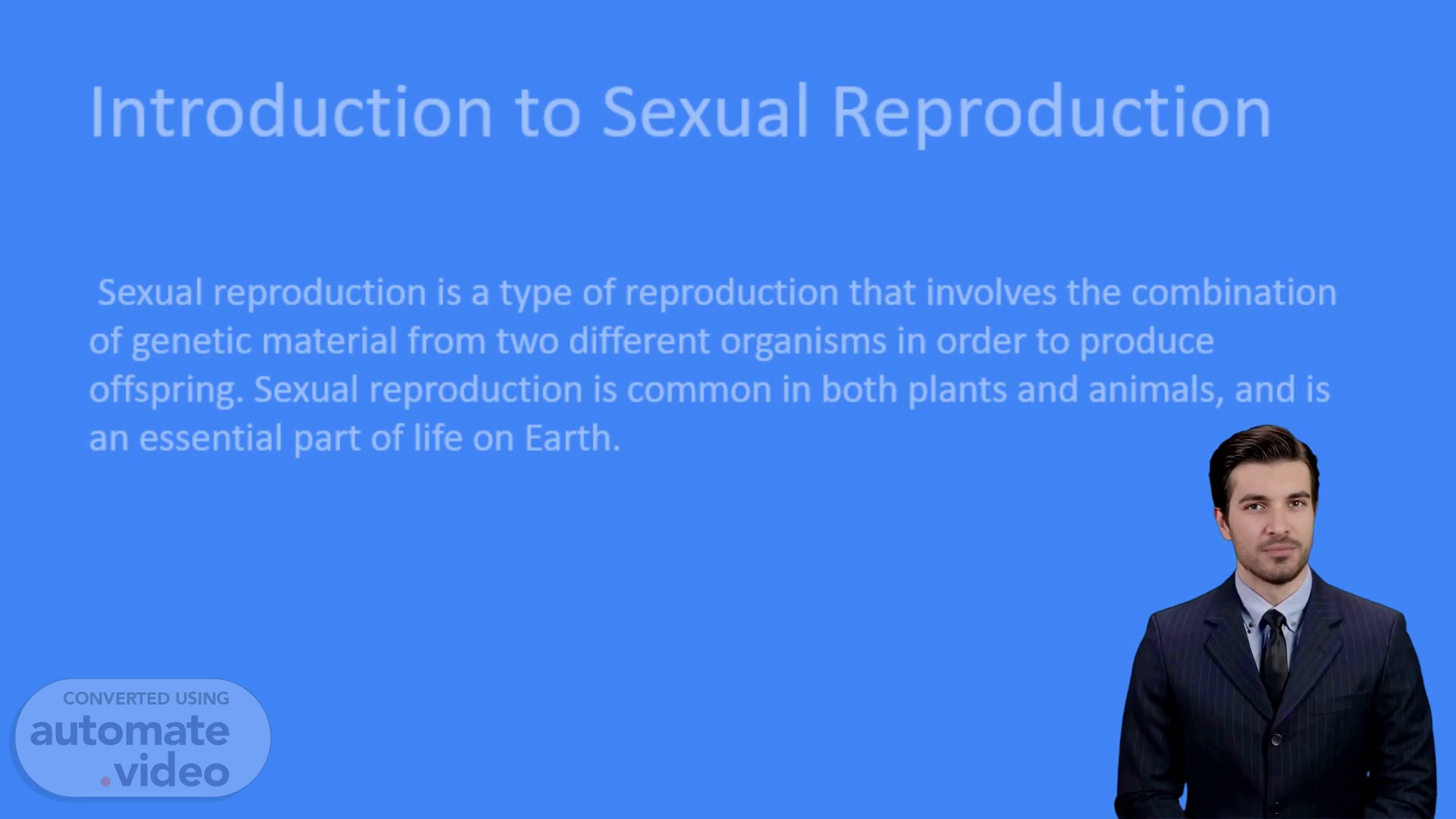
Page 1 (0s)
[Virtual Presenter] Sexual reproduction is a process which takes place naturally in plants and animals, and is vital for the persistence of life. Throughout sexual reproduction, genetic material is intermingled between two different organisms to create new offspring. This ensures genetic diversity and ensures the preservation of life on Earth..
Page 2 (22s)
[Audio] Sexual reproduction is a method employed by numerous plants and animals. In plants, pollination transpires where the egg of the female is fertilized by the pollen of the male. This procedure produces seeds with genetic material from both parents. These seeds when planted, result in the cultivation of new plants..
Page 3 (45s)
[Audio] Sexual reproduction is a significant form of procreation for both plants and animals. In humans, it involves the fusion of an egg from the female with a sperm from the male, forming a zygote containing genetic material from both parents. This zygote then grows into an embryo and eventually a baby. The importance of sexual reproduction in humans lies in its ability to pass on genetic information to the next generation..
Page 4 (1m 13s)
[Audio] Sexual reproduction is a form of reproduction seen in plants and animals alike. It has the ability to bring about greater genetic diversity and adaptability, allowing for the introduction of new combinations of traits that can aid in survival. This helps organisms to adapt to the ever-changing environment. Additionally, as two sets of genetic material are combined, it provides for greater variation among offspring, aiding in species conservation..
Page 5 (1m 43s)
[Audio] Sexual reproduction involves the exchange of genetic material from two parents, making it a more complex process than asexual reproduction. It may take longer to produce offspring, be limited to two parents, and require more energy expenditure, but these drawbacks can be overcome by other forms of reproduction, such as asexual reproduction..
Page 6 (2m 5s)
[Audio] The reproductive system in plants comprises of the male and female systems. The male system is made up of the stamens which produce male pollen while the female system consists of the pistils which bear female eggs. When the pollen from the male system meets the egg from the female system, fertilization takes place generating an offspring..
Page 7 (2m 28s)
[Audio] The human reproductive system consists of two parts - the male reproductive system and the female reproductive system. The male reproductive system is comprised of the testes, producing male gametes (or sperm), while the female reproductive system consists of the ovaries, producing female gametes (or eggs). Through sexual reproduction, the gametes are combined, producing an organism with genetic material from both of its parents..
Page 8 (2m 56s)
[Audio] Sexual reproduction in plants requires both flowers and fruits. In the flowers, the male and female reproductive organs produce pollen and eggs. Fruits contain the seeds, with genetic material from both parents combined, producing the offspring. Through understanding the process of sexual reproduction in plants, we can deepen our knowledge of how the natural environment reproduces and evolves..
Page 9 (3m 23s)
[Audio] The genetic material of a male and a female organism combine to create offspring in sexual reproduction in humans. The male organism has the penis and scrotum, which are the external genitalia and house the testes, while the female has the vulva and vagina which are the external genitalia and house the ovaries..
Page 10 (3m 43s)
[Audio] "Sexual reproduction is a type of reproduction which involves the combination of genetic material from two organisms to produce offspring. In plants, hormones play an important role in the process. These hormones control the development of the male and female reproductive organs, the production of pollen and eggs, as well as the maturation of the fruits and the seeds..
Page 11 (4m 7s)
[Audio] Hormones are integral to maintaining the reproductive cycle of humans. Estrogen and progesterone, two key hormones, are necessary for the proper development of the female reproductive system. Estrogen is responsible for the formation of the female reproductive organs, while progesterone is responsible for the endometrial lining of the uterus, which is essential for pregnancy. Furthermore, these hormones are in charge of the production of eggs and the triggering of ovulation. Additionally, progesterone plays a significant role in sustaining a pregnancy..
Page 12 (4m 43s)
[Audio] Sexual reproduction is a form of reproduction which involves two different organisms, both plants and animals, combining their genetic material to create offspring. Examining the process of sexual reproduction in plants and humans requires examining the structures involved, the hormones responsible, and the end product. Though both humans and plants are able to produce offspring through sexual reproduction, there are differences that set them apart..
Page 13 (5m 10s)
[Audio] Sexual reproduction provides organisms with a powerful way to expand their genetic diversity. By combining genetic material from two different organisms, it can create genetic variation which can help the offspring to adapt to their environment, thus boosting their chances of survival. This can be highly beneficial for both plants and animals, as it is an essential factor for their long-term survival..
Page 14 (5m 36s)
[Audio] Sexual reproduction is an incredibly widespread form of reproduction, found in a wide variety of plants and animals. It has several advantages which provide an evolutionary advantage to the species involved, namely, increased genetic diversity, increased adaptability to changing environments, and genetic variation. These are all vital for species survival..
Page 15 (6m 0s)
[Audio] Sexual reproduction involves combining genetic material from two different organisms to produce offspring. It is a common form of reproduction among plants and animals, offering both advantages and disadvantages and resulting in genetic variation. Comparing sexual reproduction in plants and humans also reveals differences and similarities. Thank you for listening..